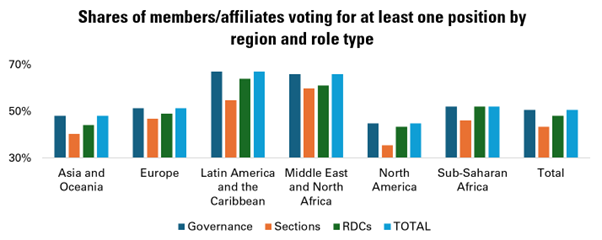IFLA elections and nominations: data analysis
24 June 2025
Over half of IFLA’s members took part in our elections this year, while more than one in five nominated a candidate. Within this, Latin America and the Caribbean and the Middle East and North Africa stood out for their mobilisation, while overall we saw an increase in the regional diversity of the membership of our Section standing commitees.
Engagement in nominations and elections not only represents a key way in which IFLA’s members can help shape the Federation, but also a means of giving individual library and information workers access to the personal and professional development opportunities that committee membership brings.
Looking at (anonymised) data gives us a useful opportunity to to understand more about how far these opportunities are being taken up, and what progress we are making towards the goal of greater regional diversity in our work.

For example, it can be shown in the graph above that 51% of IFLA members overall cast at least one vote in the elections (light blue bar), with the same share doing so in one of our governance units (President-elect, Treasurer, Governing Board Member at Large, Regional Council Chair).
Overall, Latin America and the Caribbean and the Middle East and North Africa (with turnout of over 60% of members) stand out for their level of engagement.
A new report shares key results from this, including:
- A quarter of eligible members made a nomination for an Advisory Committee, while 21% made one for a Section. Given that members can be registered to more than one Section, the overall share of opportunities to nominate taken up was higher though, at 26%.
- 20% of Middle East and North African members made nominations in every contest for which they could, while less than 5% of North American and Latin American and Caribbean members did so.
- Associations tended to be most engaged, with 41% making at least one nomination, while 22% of institutions did so, and 25% of affiliates.
- In elections, strongest turnout was for Governing Board roles, and in particular the President-elect, followed by Regional Division Committees and then Sections. Nonetheless, turnout in Section elections varied from 67% to 42%.
- Overall, the regional diversity of IFLA’s volunteer community has remained stable, but has increased in the case of our Sections and Review Groups.
- There have been slight falls in the regional spread of membership of different groups (number of regions present on each committee), but co-option processes should help in this regard, as they have in the past.
- Overall, the level of mobilisation of Latin America and the Caribbean and the Middle East and North Africa means that they had a higher share of candidates and elected volunteers than they do of members. Sub-Saharan Africa nonetheless saw a lower share of elected volunteers than their share of membership.
- Europe did particularly well in terms of elected volunteers, and in particular those on governance committees. While North America is also strongly present on governance committees, it represented a lower share of candidates and successfully elected volunteers than its share of IFLA’s overall membership.
Download the full analysis for more.